
Building A Custom Guitar with Matt Cremona | Crimson Guitar
- Home Decor DIY Projects
- April Wilkerson
- Updated: February 26, 2023
Thinking about building your own fully custom guitar? Check out this awesome DIY project where I literally built a cool custom guitar for myself!
Triton Tools surprised Matt Cremona and I with a trip to the UK to build a custom electric guitar in the brand new school of Crimson Guitars. Ben runs his own channel covering everything to do with guitar making but also has a school, which just expanded to holding 13 students at a time. It was such a memorable week…fun, educational, and I walked away with a build that I’ll treasure for the rest of my life. It’s fascinating just how much goes into guitar building and over the next two videos, I’m going to cover the process.
Ok, lets get started….
ISOtunes Bluetooth Hearing Protection
Spindle Sander
Router Table
Thickness Planer
Router
CA Glue
Bessey Inline Handle Clamps
I started off by picking out the wood for all the components of my guitar. I have roasted sycamore for the neck, Ebony for the fret board, then a cracked piece of alder for the body.

I didn’t know a thing about guitars before going into this build but I knew I wanted a body with a crack so I could incorporate some bow ties.

Setting the body aside, I started with the neck.
Now, I don’t know a thing about guitar making.…so while I did the work, I had a luthier named Chris working along side me through the build, explaining what to do and making sure I didn’t mess up. So note you don’t have to be a woodworker to build your own guitar. Crimson has plenty of people take the course who have never used tools before.

After temporarily attaching the neck template to my sycamore, I walked it back to the wood shop at the back of the classroom to cut it out. Or at least do a rough cut out where I removed the bulk of the material.

Matt was working on the start of his body whileI was working on my neck. Be sure to check out Triton Tools videos HERE which shows Matts build as well as plenty of behind the scenes that I don’t cover.
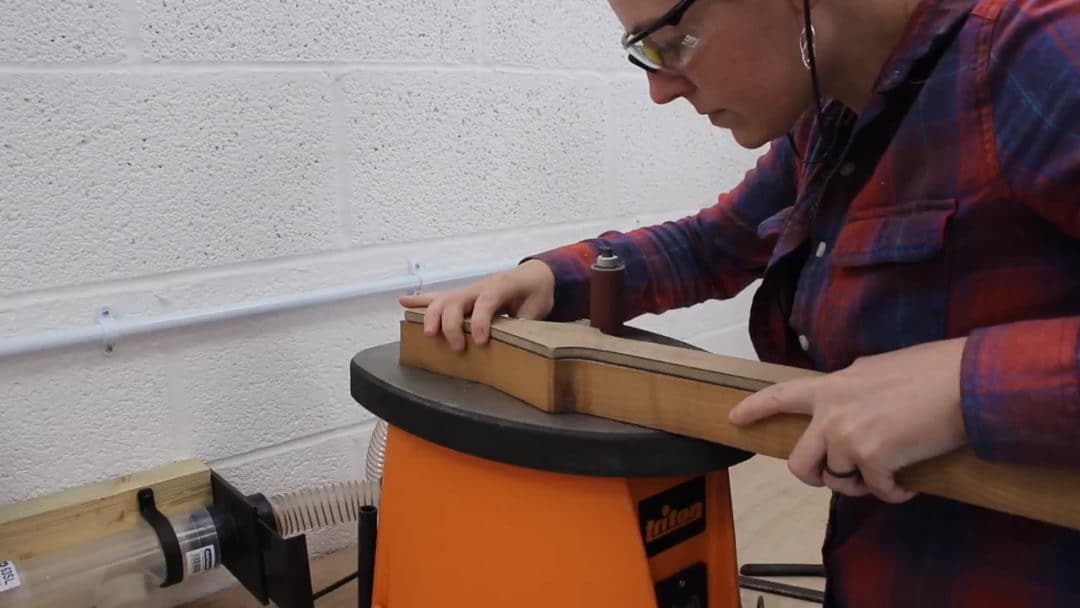

After finishing off the final shape to the template with a flush trim bit in the Triton Workcenter, I pulled the template off and cut down the neck to roughly the thickness needed. You can see it’s a rather thick chunk of wood to start. After resewing it at the bandsaw, I threw it through the Thickness Planer for a few passes to get it to final thickness.
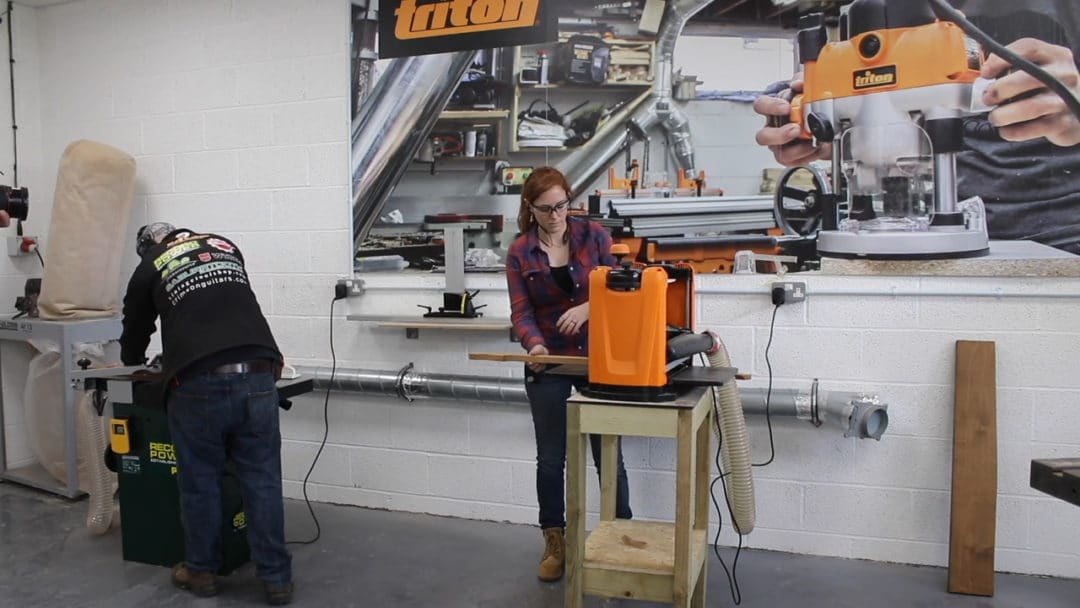
Oh and you see Ben there working, he was inspired watching Matt and I and started on his own guitar. You can see that build over on his channel HERE.

Getting back to the workbench, I made a few marks to find center on the neck because next was attaching a jig to cut in a slot to fit in the truss rod.

The jig not only dictates the width of the truss rod cavity for the router but we set a screw to act as a stop for the exact length of my particular rod.

This way, when over at the Router, I can start off with the bit high, use the plunge feature to sink into the wood, push the router forward and it stop up against that screw.

The Router leaves a rounded slot so some slight clean up work is needed with a chisel to square things off, until that truss rod can slip in.


Next was to temporarily attach the fret board to a fret board making template of Crimson’s and this attaching method is one of the most handy tricks I’ve picked up this year! You place masking tape on your work piece and also whatever you want to stick it to. Burnish it by using anything around, then run a thin line of CA glue down the center of the tape. Apply pressure for a few seconds and you’re ready to rock.


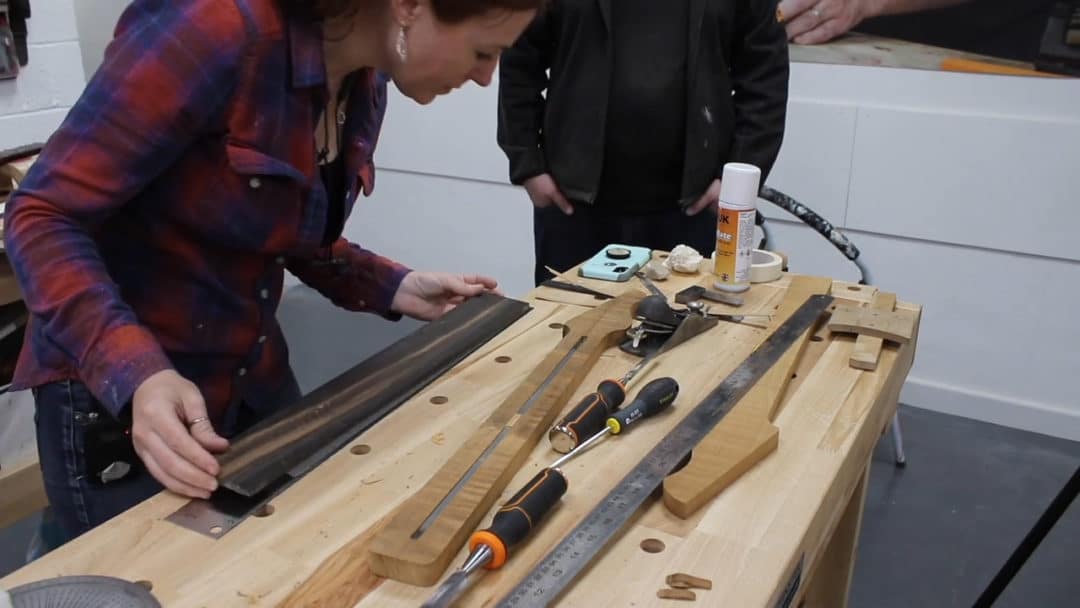
Afterwards, you peal the two apart and there is no messy residue to clean up because it’s all left on the tape which you just peal off and throw away.
So Crimson’s template has the spacing for the frets already lined out with a notch. Then they have a pin placed on the deck of the saw for this notch so you can just move your fret board along, notch by notch, until the frets are cut in.


It incredible how heavy such this thin piece of wood was. Up next cutting in a slot that will later hold a small piece of bone inlay.

I did this by using a hand saw to cut in the boundary of the bone’s position, then a tiiiiiny little chisel to hollow it out. If you’re interested in guitar making, note that Crimson makes and sells a ton of specialized tools to make the job easier.

Now it was time to attach the fret board to the neck. I first drew a few center lines on both pieces so that when I set the two on top of one another, I could use these lines to center the two to each other. And while I’m just giving you an overview of the steps, it’s worth noting that a lot of these steps took a decent amount of time.

The holes I drilled are used to place locating pins into so that after some wood glue is applied I could place the fret board on the neck until the pins found their holes, then use a curved scrap board and clamps to squish it all together until the glue dried.



Now the fret board can be trimmed and cut to final size to match the neck before moving on to one of my favorite parts of the build which was shaping the neck.

It’s a multi step process to go from a square block of wood to the nice flowing/round feel of a guitar neck.
The first being to resaw out a lot of the bulk waste at the bandsaw.

The second being to use a rasp to round over the back of the neck. I’ve never used one of these rasps but it was easy enough to pick up right away.
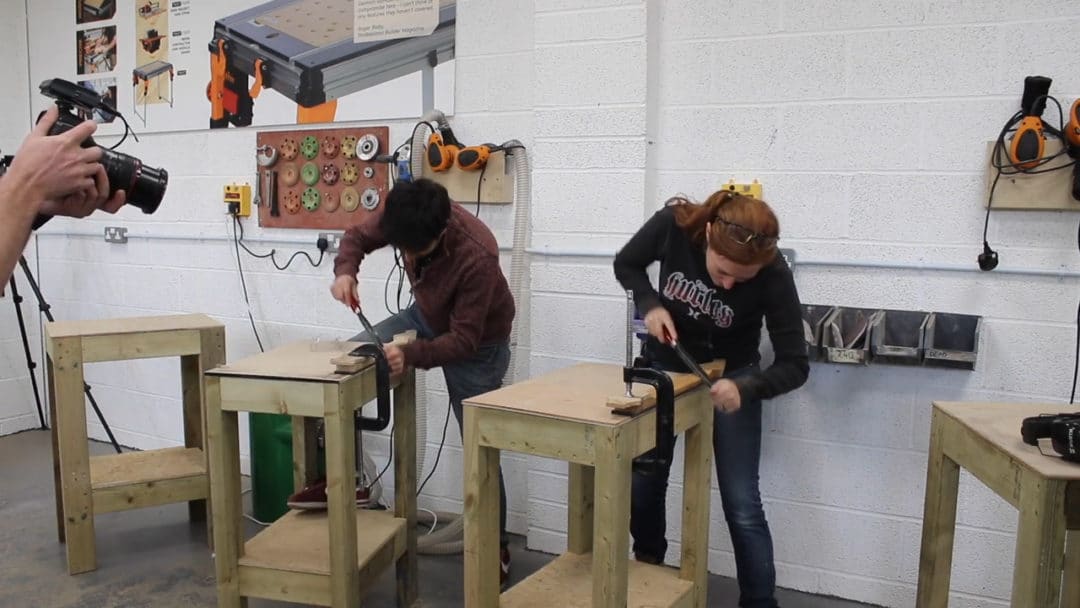
Before coming back to the shop to start shaping Cremona and I drew some guide lines on the neck so we could knock the edges down to create a nice and even bevel the entire length of the neck. Here you can see the bevel I just created on that side, then I flipped it over and repeated.
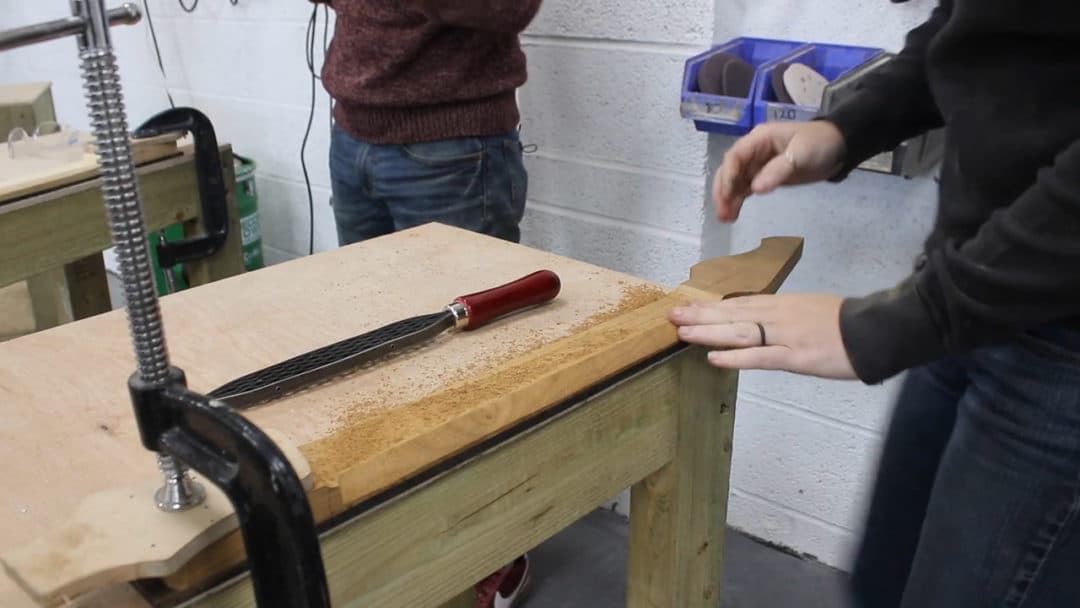
The rasp makes quick work of removing the wood, but the reason I think I liked it so much is the drastic effect it had on the feel, it was really taking shape.

After getting both of those bevels, we drew on more guide lines then knocked down more wood to give the neck it’s final shape.

While here, we also shaped the head stock of the guitars.
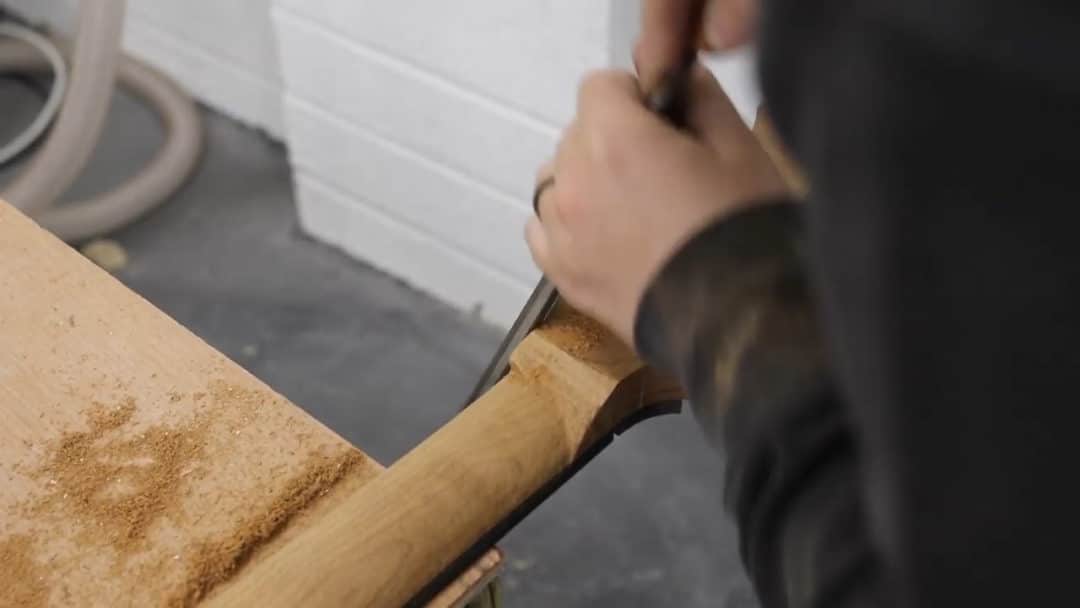
BTW: can we just gawk for a moment at all that flame in this Sycamore?
Now this shape wasn’t as easy to get, as the neck. It’s more much windy and free flowing but again, Chris was nearby and made me feel confident that I wasn’t messing it up.

After getting this shape cut in, it was a bunch of hand sanding to remove all the big scratches.

Now on to the head stock.
First was to attach a template for my style of guitar (Cremona chose a different style) and drill in the tuning holes then using the bandsaw to remove the bulk of waste before refining it.

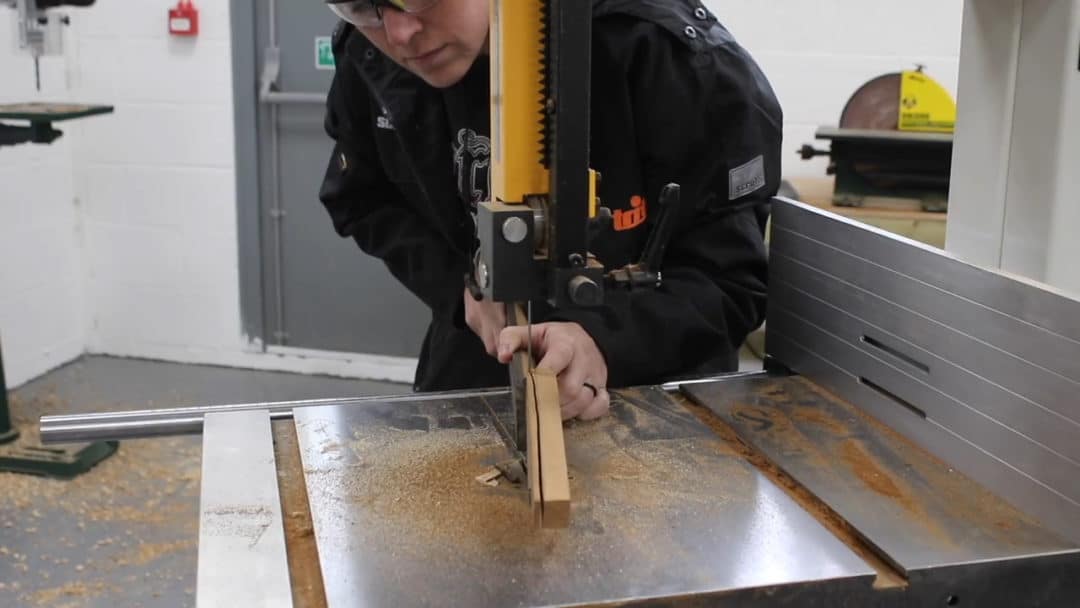
Now this was another cool trick I took away from the week…using a Spindle Sander as a thickness planer. I think that’s so clever! They set up a fence (scrap piece of wood, clamped to the deck) set to the thickness the headstock needed to be. This way I could run it until it was all the same thickness annnnnd it gave me that nice curved bit going into the frets.
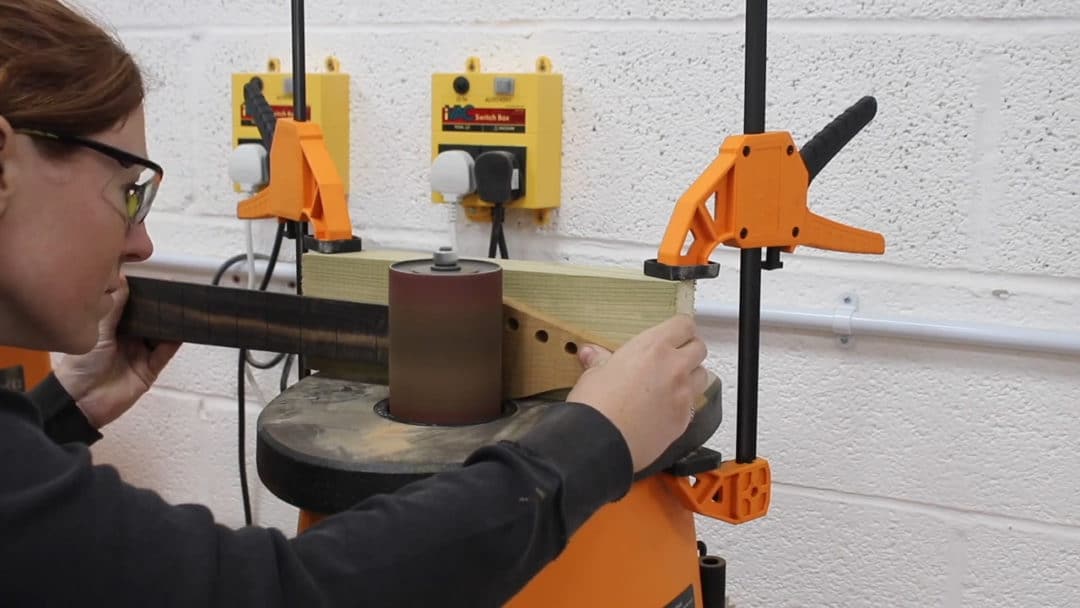
Oh goodness, this is taking shape guys! But still more shaping to go. You know, I never really paid attention to how many different areas of the guitar are shaped differently. Once you hand cut or sand those shapes in, you’ll always notice.
Next thing to shape was our fret boards. Taking them from a square flat piece of wood, to a rounded curved surface. This is done by using a piece of wood that has a cove cut into it and just going back and forth…..back and forth……back and forth.

Now a nerve wracking step! Remember that truss rod I put in the neck earlier? Well now was to drill an access hole to tighten or loosen it which in turns bends the neck to straighten it out. I was terrified that I would mess up my beautiful neck, but the operation went very smoothly. Matt and I were joking that even in guitar building I managed to work a pocket hole in.

Up next was inlays. Typically some sort of marker is placed on the 12th fret because this is where the octave changes (Check that fact). Chris gave me some mother of pearl to first cover in tape then draw out the shape I wanted.

Another new tool for me to use was an inlay jig. Chris gave me a quick run down then I went to town. This is a really handy tool. The saw can turn on a dime and actually eats through material quickly, the only tricky part is you need to keep the handle straight up and down. You can see as I’m using it, I keep pulling the handle back towards my body. I suppose just like everything else, it takes practice to get it. Either way, I got both my bowties cut out in no time, so the next step was to cut in the matching shape into my fret board where they will be inserted.

I first traced around them using a scalpel then used a rotary tool mounted on a base that controls the depth and cut as close to my markings as possible, without going over.


This hogged away the majority of the material where I just had to come back to do the final bit with a chisel. Then I could glue the bowties in. : ) That’s my first inlay. And I like it.

Now was sanding it down flush! There is a lot of sanding in guitar making. But having friends around to cut up with makes it very enjoyable.

Ah! You ready to see this ebony under finish?? This isn’t the final finish but next we put on a coat of protective oil that crimson makes. This gives the frets a coat of protection from the super glue that we’ll be applying the frets with in the next step.

Alright hold onto your patience because the next major step was the fret work and this was an entire day step. It is tedious but honestly, I didn’t mind it. The first thing was to use a hand saw to clear out each and every fret. Goes quick enough.

Next was to enlarge the top of the fret slots with a triangle file. A few swipe a piece is all this takes.

Now to cut each fret, just slightly long at this point, from a reel of fret material.

To glue them in, a small amount of CA glue was placed on the underside of each fret then frimly hammered into place.
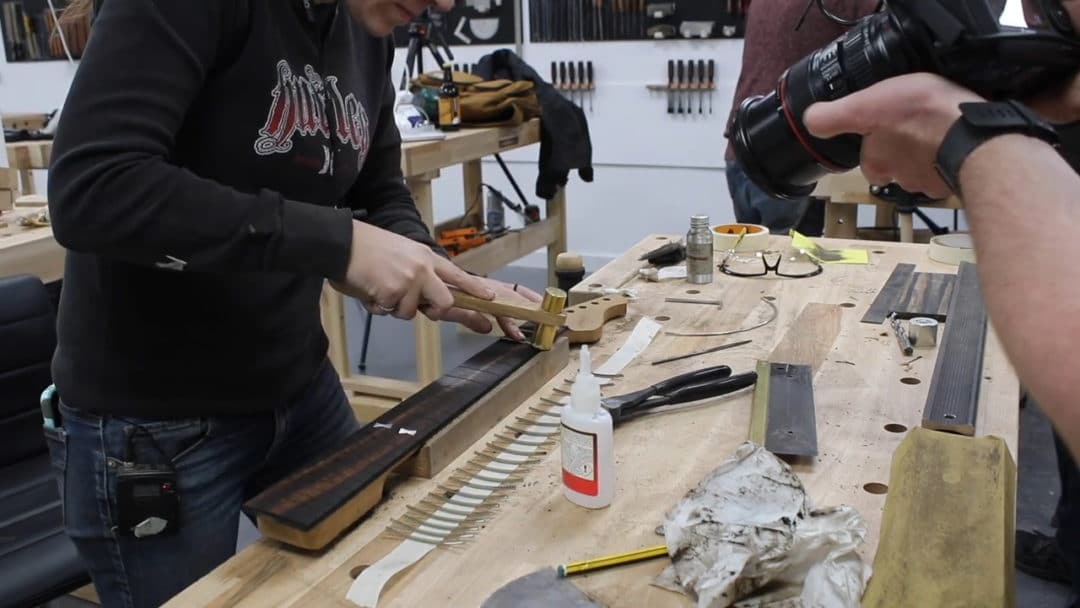
You can kind of see that I hit the top then the bottom then in center and the fret not only compresses into the slot but also flattens out. You can also see that I’m using a curved holder lined with cork under my neck to protect it during this process. Matt was joking with me about how aggressively I hammered these in, but it paid off!

After going through and snipping off the bulk of overhanging material on both sides, I came back with a file. First with the file at a 90 to the neck, then once flush, again at a slight angle. Little details like that are small, but in the end result they actually make a difference.


Right now I have frets that are round, well we need to sand the tops so they are flat….but then we end up rounded them back out later. ….I know luthiers have a good reason for this, I just can’t remember what it is.
First, I placed black sharpie over the tops then got to sanding until all the sharpie marks were gone. Notice I’m not taking big sweeping back and forth motions with the sanding block. Instead I’m trying to keep the majority of the block on the neck to ensure it stays nice and flat.

Next was to go through and use a Crimson specialty tool to find any high frets. This spans three frets at a time and indicates rocks. When you find one that rocks, you need to sand it down more. However, apparently I did such a great job at setting my frets, that I didn’t have a single high fret : ) This drastically cut down on the amount of sanding I had to do. And I got to tell Cremona Ha! Because he had lots of sanding to get his level : )
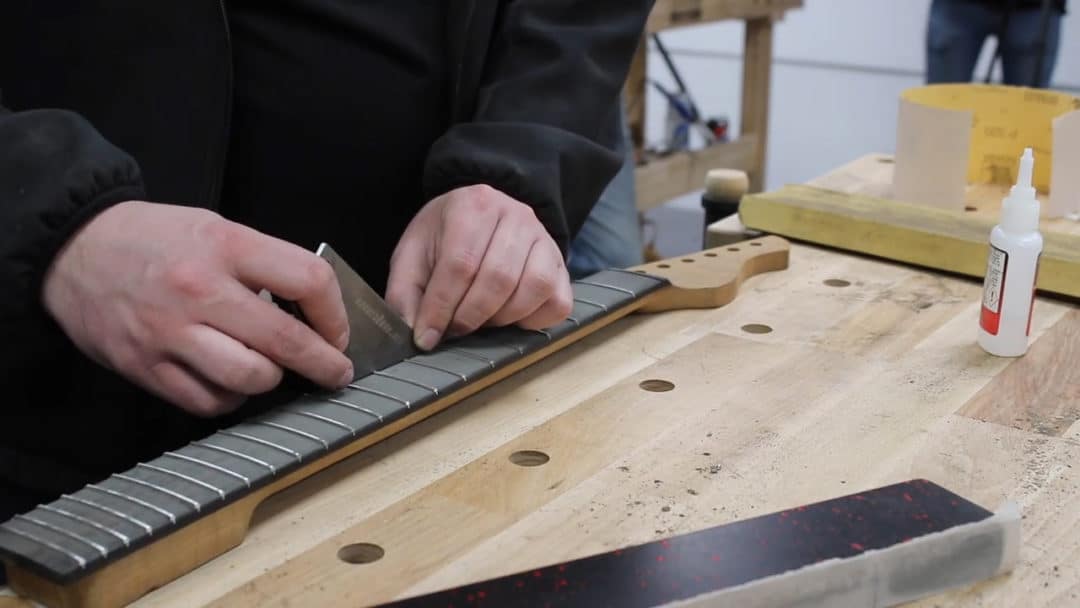
But not done with sanding yet. Now was to tape off a small back portion of the frets and sand them down to be slightly lower than the front ones.
And now to file the frets back to round. I went to each fret individually and placed this protected covering with a slot in it over each fret. Then used a hand file to get each side back to round. This protective cover of course protects the fret board, which in my case is ebony. I recommend you go ahead and pull up a chair to rest your feet while you work, because this doesn’t go quick.

Next was to still use the protective cover but change out the file to sandpaper.

Instead of leaving the ends at the same angle I filed in earlier with the block file, now was to come back with a small rat file and round the corners, so four per fret, to eliminate all sharp edges. Again, a small thing. But gliding a hand up and down the frets before and after, does actually make a difference. Go ahead and pull up a chair because while I’m skimming though these steps for you guys, it’s a time consuming process.

Unless I’m misremembering, that’s it for the fret shaping!
Next was to clean up the fret board and get rid of all the smeared CA glue or scratches, or anything else. This was done with a razor blade, which I had never seen before but it worked very well. I just moved the blade portion back and forth across the frets to scrap the surface in between each fret.

After the obvious stuff was scrapped then I came back with sand paper rolled over a finger then ran through the grits.

And with that, we are getting closer to the end of fret work guys!
Next was to apply another coat of finish to clean off the fret board wood then tape off the wood so the neck could be taken over to a grinder wheel and all the frets can be buffed and polished.

Now don’t get me wrong, even though it is a tremendous amount of tedious steps to get these frets tip top, I was having a great time. You’ll notice in lots of the clips, I’m smiling or laughing and that’s because we were all chatting and laughing throughout this process. So don’t let the heavy detail work sway you from this. It honestly is just fine and it makes taking off that tape to reveal such beautifully shaped and shiny frets even more rewarding since I know I put in every single detail to get it there.

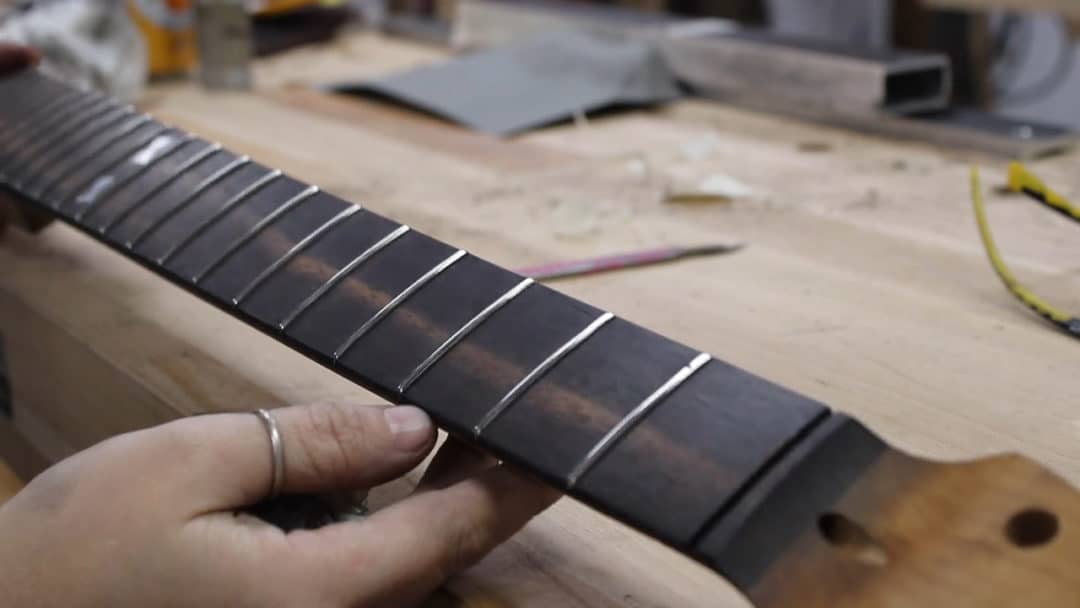
On to one of the last additions to the neck is the fret markers. I drilled a small hole at the center of each fret, slightly beveled the tip of a white synthetic material, dabbed the end in CA glue then inserted it in. After all were placed, each one was cut as close to flush as possible then filed down to be perfectly flush.


Whew, and that’s it! Other than the final sanding of course.
Ben taught me how to use a card scraper then Cremona and I spent the last remaining bit of the day getting out any and all scratches in the neck until they were flawless.

This was an incredible experience on so many levels. I learned so so much during this build, even during this neck building portion alone I learned a pocket full of tricks that I’ll always carry.

If you enjoyed this stay tuned for my next video which cover the body making portion of the guitar and joining the neck to the body of course.

I also highly encourage you to check out Triton Tool’s videos where they cover day by day, which was five days of our experience. Then also the Crimson Guitar’s channel, as they are the resource to watch in the guitar building world. And my buddy Matt Cremona’s channel is here.
Big thank you to Triton and Crimson Guitars for this experience.
If you liked this project and want to stay up to date with what I’m building, then be sure to sign up for my email newsletter and you’ll get an email when I post something new.
I’ll see you guys on Part 2!